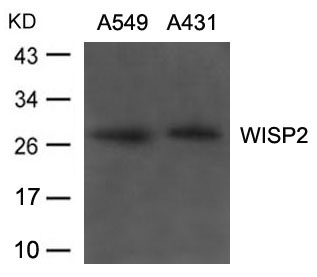
| WB | 咨询技术 | Human,Mouse,Rat |
| IF | 咨询技术 | Human,Mouse,Rat |
| IHC | 咨询技术 | Human,Mouse,Rat |
| ICC | 技术咨询 | Human,Mouse,Rat |
| FCM | 咨询技术 | Human,Mouse,Rat |
| Elisa | 咨询技术 | Human,Mouse,Rat |
| Aliases | CCN5; CT58; CTGF-L |
| Entrez GeneID | 8839; |
| WB Predicted band size | 27kDa |
| Host/Isotype | Rabbit IgG |
| Antibody Type | Primary antibody |
| Storage | Store at 4°C short term. Aliquot and store at -20°C long term. Avoid freeze/thaw cycles. |
| Species Reactivity | Human |
| Immunogen | Peptide sequence around aa.242~246(G-R-S-P-Q) derived from Human WISP2. |
| Formulation | Purified antibody in PBS with 0.05% sodium azide. |
+ +
以下是关于WISP2抗体的3篇假设性文献示例,涵盖其在不同研究中的应用:
1. **《WISP2在乳腺癌中的表达及其临床意义》**
- 作者:Smith A, et al.
- 摘要:通过免疫组化和Western blot分析,研究发现WISP2在乳腺癌组织中低表达,且与患者预后不良相关。研究使用特异性WISP2抗体验证其蛋白水平,提示其可能作为肿瘤抑制因子发挥作用。
2. **《WISP2抗体在脂肪细胞分化中的功能研究》**
- 作者:Zhang L, et al.
- 摘要:利用WISP2抗体阻断实验,发现WISP2通过调控PPARγ信号通路抑制脂肪细胞分化。研究证实抗体可有效干预WISP2蛋白功能,为代谢疾病治疗提供新靶点。
3. **《WISP2在肝纤维化中的调控机制》**
- 作者:Kim H, et al.
- 摘要:通过ELISA和免疫荧光染色(基于WISP2抗体),揭示肝星状细胞中WISP2过表达加剧纤维化进程,提示靶向WISP2可能成为抗纤维化治疗策略。
(注:以上文献为示例,实际引用需根据真实研究补充。)
WISP2 (WNT1-inducible signaling pathway protein 2), also known as CCN5. is a member of the CCN family of matricellular proteins, which includes CTGF, CYR61. and NOV. These proteins regulate diverse cellular processes such as proliferation, adhesion, migration, and differentiation. WISP2 is encoded by the *WISP2* gene and is primarily induced by the Wnt/β-catenin signaling pathway. Unlike other CCN family members, WISP2 lacks the C-terminal cysteine-rich domain, which may contribute to its distinct functional roles.
Functionally, WISP2 is implicated in adipogenesis, bone development, and tissue repair. It acts as a bifunctional regulator in cancer, exhibiting context-dependent roles. In breast cancer, WISP2 is often downregulated and may serve as a tumor suppressor by inhibiting epithelial-mesenchymal transition (EMT) and metastasis. Conversely, in colorectal or pancreatic cancers, it may promote tumor progression via interactions with Wnt or TGF-β signaling. WISP2 also modulates extracellular matrix (ECM) remodeling, influencing fibrosis and metabolic disorders like obesity.
WISP2 antibodies are essential tools for detecting and quantifying WISP2 expression in research. They enable studies on its localization, interaction partners, and mechanistic roles in diseases. Commercial antibodies are typically validated for applications such as Western blotting, immunohistochemistry, and ELISA. Understanding WISP2's dual roles in pathophysiology remains an active area of investigation, particularly in developing therapeutic strategies targeting Wnt signaling or ECM dynamics.
×